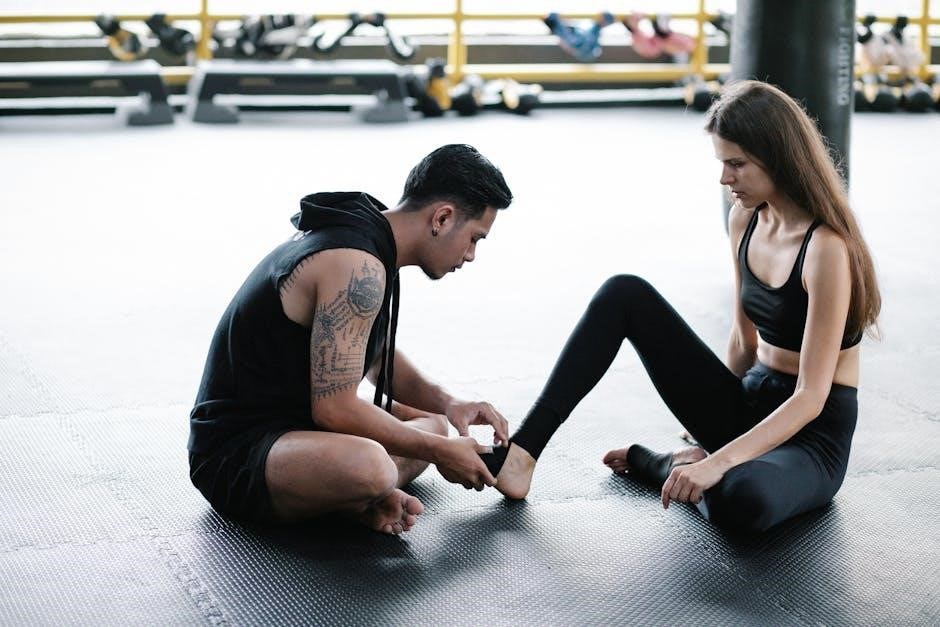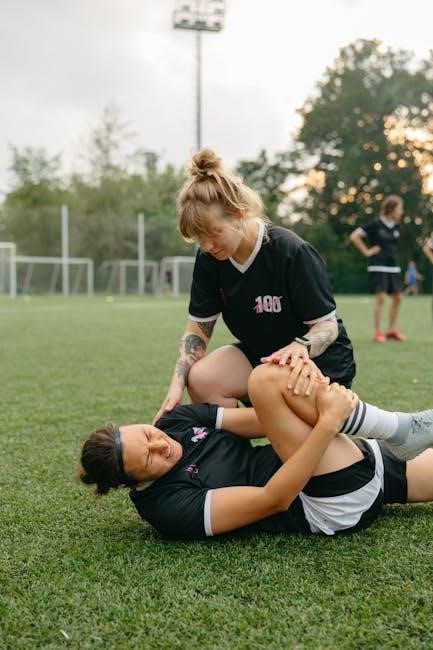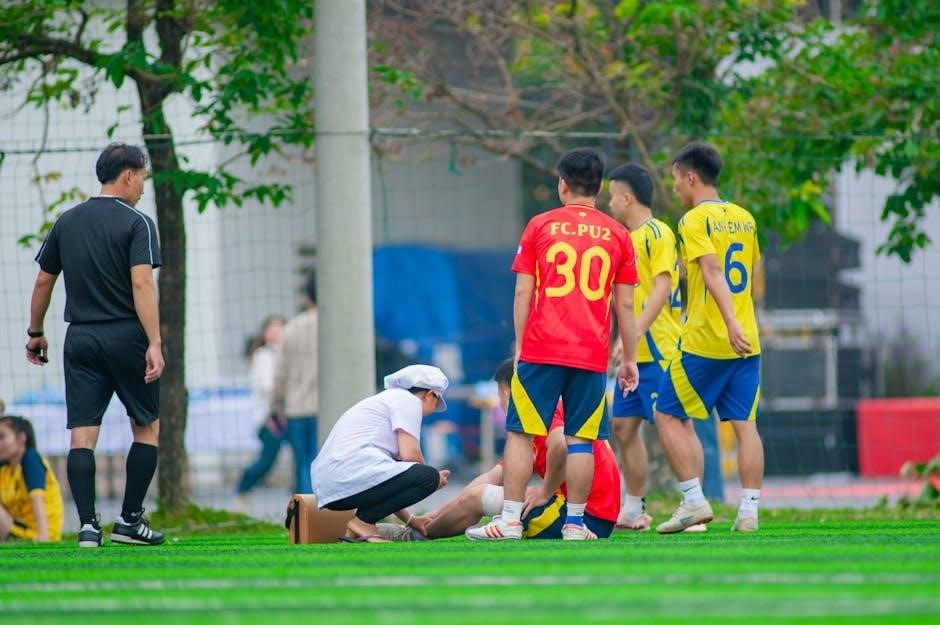Rotator cuff injury exercises are crucial for rehabilitation, focusing on restoring strength, flexibility, and mobility to the shoulder muscles. They include isometric, passive, and active exercises, tailored to individual recovery needs, ensuring proper healing and preventing further injury. Consistency and professional guidance are key to effective recovery.
1.1 Understanding the Rotator Cuff and Its Importance
The rotator cuff is a group of four muscles and tendons surrounding the shoulder joint, providing stability and enabling smooth movement. It includes the supraspinatus, infraspinatus, teres minor, and subscapularis muscles. These muscles work together to stabilize the shoulder during activities like lifting, rotating, and overhead movements. A healthy rotator cuff is essential for maintaining shoulder mobility and preventing injuries. Damage to the rotator cuff can lead to pain, weakness, and limited range of motion, making everyday tasks challenging. Proper care and strengthening of the rotator cuff are vital for long-term shoulder health.
1.2 Common Causes of Rotator Cuff Injuries
Rotator cuff injuries often result from repetitive overhead movements, sports-related trauma, or falls. Aging, poor posture, and muscle imbalances can weaken the rotator cuff, making it prone to strains or tears. Overuse in activities like swimming, pitching, or lifting heavy objects also increases risk. Additionally, sudden injuries, such as direct blows to the shoulder or awkward landings, can cause immediate damage. Early identification of these causes is crucial for effective treatment and prevention of further complications.
1.3 The Role of Exercise in Rehabilitation
Exercise plays a vital role in rotator cuff rehabilitation by restoring strength, improving mobility, and reducing pain. Targeted exercises, such as isometric and passive motion routines, help rebuild muscle stability and promote healing. Consistency in performing these exercises ensures gradual recovery and prevents further injury. Professional guidance is essential to tailor exercises to individual needs, fostering a safe and effective rehabilitation process. Regular practice strengthens the shoulder muscles, enhancing overall joint stability and function.

Getting Started with Rotator Cuff Exercises
Begin with a warm-up, such as light cardio or dynamic stretches, to prepare the shoulder for exercise. Maintain proper posture to avoid strain and ensure safe movements.
2.1 Warm-Up and Preparation
A proper warm-up is essential before starting rotator cuff exercises to prepare the muscles and joints; Begin with 5-10 minutes of low-impact activity, such as walking or cycling, to increase blood flow. Gentle stretching, like shoulder rolls and cross-body stretches, can help improve flexibility and range of motion. Avoid forcing movements that cause pain. Keep the injured arm relaxed during stretches to prevent further strain. This preparation ensures a safe and effective transition into the exercise routine.
2.2 Importance of Posture in Exercises
Maintaining proper posture during rotator cuff exercises is crucial to prevent strain and ensure effective healing. Keep shoulders relaxed, rolled back, and down to avoid unnecessary tension. Poor posture can lead to improper muscle activation, potentially worsening injury. Regular posture exercises, such as shoulder rolls and upright sitting, help reinforce good alignment. This alignment supports the rotator cuff muscles, promoting balanced strength and reducing the risk of further injury during rehabilitation. Consistent attention to posture enhances the effectiveness of exercises and accelerates recovery.
2.3 Setting Realistic Goals for Rehabilitation
Setting realistic goals for rotator cuff rehabilitation is essential to ensure steady progress and avoid discouragement. Goals should be specific, measurable, and tailored to your injury severity and daily needs. A physical therapist can help create a personalized plan, focusing on achievable milestones like improving range of motion or reducing pain. Understanding the recovery timeline and avoiding overexertion is crucial. Celebrate small victories, as consistent effort and patience are key to successful rehabilitation. This structured approach enhances motivation and adherence to the exercise program.

Types of Rotator Cuff Exercises
Rotator cuff exercises include isometric, passive motion, active assisted, and active range of motion. These target strength, flexibility, and joint stability, promoting recovery and preventing further injury.
3.1 Isometric Shoulder Exercises
Isometric shoulder exercises, like external rotation in a doorway, strengthen muscles without joint movement. Stand with elbow bent, press hand outward, hold 5 seconds, 3 sets of 10. These exercises maintain strength and range of motion, essential for early recovery. They are low-impact, reducing strain on the injured area. Focus on controlled movements, avoiding pain. Isometric exercises are ideal for initial stages, promoting stability and preparing for more dynamic movements. Consistency is key for gradual strength improvement and injury prevention.
3.2 Passive Motion Exercises
Passive motion exercises involve gentle, assisted movements to improve shoulder mobility without active muscle engagement. Examples include pendulum swings and cross-body stretches. These exercises are performed within a pain-free range, typically 3 sets of 10 repetitions. They are essential in the early stages of recovery to prevent stiffness and promote healing. A therapist or helper may assist to ensure proper technique and avoid overexertion. Consistency in performing these exercises helps restore range of motion and supports the rotator cuff’s natural recovery process.
3.3 Active Assisted Range of Motion Exercises
Active assisted range of motion exercises combine partial effort from the injured arm with assistance from the unaffected arm or a device. Examples include arm raises, cross-body stretches, and lateral raises. These exercises are performed within a pain-free range, typically 3 sets of 8-12 repetitions. They help improve mobility, strengthen muscles, and reduce stiffness. Progressing gradually and avoiding pain ensures effective recovery and prevents further injury to the rotator cuff.
3.4 Active Range of Motion Exercises
Active range of motion exercises involve moving the shoulder without assistance, using the muscles around the joint. Examples include arm circles, shoulder rolls, and lateral raises. These exercises strengthen the rotator cuff, improve flexibility, and restore mobility. Perform 3 sets of 10-15 repetitions daily, focusing on controlled movements. Start slowly, gradually increasing difficulty as strength improves. Avoid pain during exercises to prevent further injury and ensure proper healing of the rotator cuff.

Strengthening the Rotator Cuff
Strengthening the rotator cuff involves targeted exercises to build muscle endurance and improve joint stability. Focus on lateral raises, shoulder presses, and resistance bands to enhance muscle function and prevent future injuries.
4.1 Isometric Strengthening Techniques
Isometric strengthening techniques involve contracting the rotator cuff muscles without moving the joint. Exercises like wall slides and shoulder holds are effective for building strength and stability. These techniques are low-impact, reducing the risk of further injury while improving endurance and control. They are particularly beneficial in the early stages of rehabilitation, as they allow for muscle activation without putting excessive strain on the healing tissues. Consistency and proper form are key to maximizing their benefits.
4.2 Resisted Exercises for Muscle Building
Resisted exercises, such as shoulder external rotations with a resistance band or light weights, are essential for building muscle strength and endurance in the rotator cuff. These exercises target specific muscles, like the supraspinatus and teres minor, promoting functional recovery. Progression involves increasing resistance gradually, ensuring proper form to avoid strain. Examples include lateral raises and internal rotations, which enhance stability and power. Resisted exercises are particularly effective in the later stages of rehabilitation, helping restore full shoulder function and preventing future injuries.
4.3 Scapular Strengthening to Support the Rotator Cuff
Scapular strengthening is vital for supporting the rotator cuff, as weak or imbalanced shoulder blade muscles can lead to poor posture and increased injury risk. Exercises like shoulder blade squeezes, wall slides, and rows target the scapular stabilizers. These movements improve shoulder blade positioning and reduce strain on the rotator cuff. Strengthening the scapula enhances overall shoulder stability, promoting proper mechanics and reducing the likelihood of muscle imbalances that can exacerbate rotator cuff injuries.

Rehabilitation Timeline and Progression
Rehabilitation after rotator cuff injury typically spans 6-12 months, progressing from passive to active exercises, ensuring gradual healing and strength restoration. Consistency and professional guidance are crucial for optimal recovery.
5.1 Early Stage Exercises (0-6 Weeks)
5.2 Intermediate Stage Exercises (6-12 Weeks)
At the intermediate stage (6-12 weeks), exercises progress to active-assisted and gentle strengthening movements. Wall slides, assisted external rotations, and scapular strengthening exercises are introduced to improve mobility and build strength. Light resistance, such as using resistance bands, may be incorporated to target the rotator cuff muscles. Emphasis is placed on maintaining proper form and avoiding pain. These exercises help transition from passive to active movements, preparing the shoulder for more dynamic activities while continuing to support the healing process;
5.3 Advanced Stage Exercises (Beyond 12 Weeks)
Advanced stage exercises (beyond 12 weeks) focus on dynamic strengthening and functional movements to restore full shoulder strength and mobility. These include resisted external rotations, lateral raises with light weights, and controlled overhead activities. Exercises like dynamic stabilizations and scapular wall slides are emphasized to enhance stability. Progression to higher resistance and more complex movements is tailored to individual recovery, ensuring proper technique to avoid re-injury. These exercises prepare the shoulder for return to normal activities or sports.

Pain Management and Safety
Effective pain management involves avoiding exercises that cause sharp pain, modifying movements to a pain-free range, and seeking medical advice if discomfort persists or worsens.
6.1 Avoiding Pain During Exercises
Avoiding pain during rotator cuff exercises is essential to prevent further injury. Stop any exercise if sharp pain occurs and focus on pain-free ranges of motion. Gentle stretching and strengthening within comfortable limits help promote healing without aggravating the injury. Prioritize low-resistance movements and gradually increase intensity as tolerance improves. Always consult a physical therapist to adjust exercises based on individual pain thresholds and progression.
6.2 Modifying Exercises Based on Pain Levels
Exercises should be modified based on individual pain levels to ensure safe and effective rehabilitation. If pain occurs, reduce resistance, lower the number of repetitions, or skip the exercise temporarily. Mild discomfort is acceptable, but sharp pain indicates the need for adjustment. Focus on pain-free ranges of motion and gradually increase intensity as tolerance improves. Communication with a physical therapist is crucial to tailor exercises appropriately, ensuring progress without compromising recovery.
6.3 When to Seek Medical Advice
Seek medical advice if experiencing severe pain, limited mobility, or worsening symptoms despite rehabilitation efforts. Consult a healthcare provider if pain persists or worsens during exercises, or if there is significant weakness or inability to move the arm. Immediate medical attention is needed for acute injuries or sudden increases in pain. A doctor or physical therapist can provide tailored guidance and ensure exercises are performed safely and effectively, adjusting the program as needed to promote healing and prevent further injury.

Preventing Further Injury
Preventing further injury involves maintaining proper posture, avoiding repetitive overhead motions, and using correct exercise techniques. Strengthening auxiliary muscles and improving flexibility also play a key role; Always consult a professional to ensure exercises are performed safely and effectively, reducing the risk of re-injury and promoting long-term shoulder health.
7.1 Proper Exercise Technique
Proper exercise technique is essential to prevent further injury and ensure effective rehabilitation. Maintain correct posture and engage scapular muscles to support the rotator cuff. Avoid movements that cause pain or stress the shoulder. Use slow, controlled motions and focus on full range of motion within a pain-free zone. Ensure exercises are performed as instructed by a healthcare professional or physical therapist to minimize risk and promote healing. Consistency and attention to detail are key to achieving optimal results and preventing re-injury.
7.2 Maintaining Shoulder Flexibility
Maintaining shoulder flexibility is vital for rotator cuff health and injury prevention. Regular stretching exercises, such as cross-arm stretches and posterior shoulder stretches, help improve range of motion. Perform exercises within a pain-free range to avoid further irritation. Incorporate gentle, sustained stretches rather than bouncing or forcing movements. Aim for 2-3 sets per session, focusing on the back and side of the shoulder. Consistency ensures long-term flexibility and reduces the risk of stiffness or chronic tightness.
7.3 Strengthening Auxiliary Muscles
Strengthening auxiliary muscles, such as the deltoid and scapular stabilizers, is essential for supporting the rotator cuff. Exercises like lateral raises and scapular squeezes target these muscles, improving overall shoulder stability. Perform exercises with proper form, keeping the shoulder blades down and away from the ears. Start with light resistance and progress gradually. Aim for 3 sets of 10-15 repetitions to build endurance and strength. This helps reduce strain on the rotator cuff and enhances functional movement and injury resilience.
Consistently performing rotator cuff injury exercises is vital for successful rehabilitation. A well-structured program focusing on strength, flexibility, and proper technique ensures restored shoulder function and reduces pain. Adhering to professional guidance and maintaining consistency are key to preventing future injuries. While the process can be challenging, dedication and patience lead to significant improvements in mobility and long-term shoulder health, making the effort worthwhile for lasting recovery and resilience.

Leave a Reply
You must be logged in to post a comment.